Risk Management Strategies for Mega Events: Olympic Games Analysis
VerifiedAdded on 2021/01/22
|28
|9135
|101
Report
AI Summary
This report provides a comprehensive analysis of risk management in mega events, with a specific focus on the Olympic Games. The report begins with an introduction that outlines the background, statement of the problem, research aims and objectives, research questions, and the significance of the research, along with the organization of the report. The literature review explores potential risks associated with the Olympic Games, including security threats, financial risks, and logistical challenges. It examines risk management strategies and plans, emphasizing the importance of proactive measures and adaptability. The methodology section details the research type, approach, philosophy, design, data collection, analysis, and sampling methods used in the study. The data analysis chapter presents the findings on risk identification, risk management plans, and essential features of risk management during the Olympics. The report concludes with recommendations for enhancing risk management practices, ensuring the safety and success of future Olympic Games. The research highlights the importance of identifying potential hazards, developing comprehensive security plans, and integrating risk management into the overall planning of mega events.
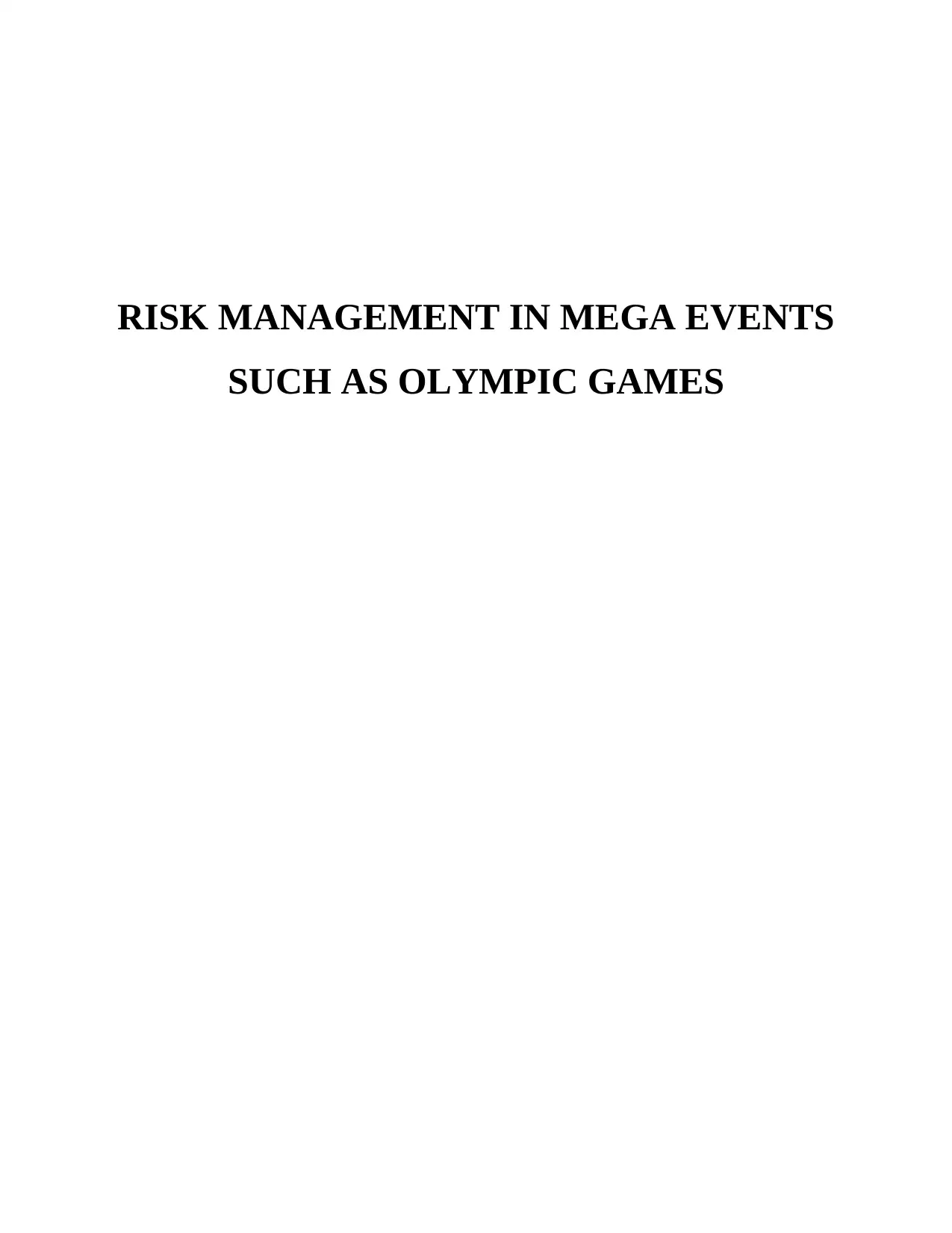
RISK MANAGEMENT IN MEGA EVENTS
SUCH AS OLYMPIC GAMES
SUCH AS OLYMPIC GAMES
Paraphrase This Document
Need a fresh take? Get an instant paraphrase of this document with our AI Paraphraser
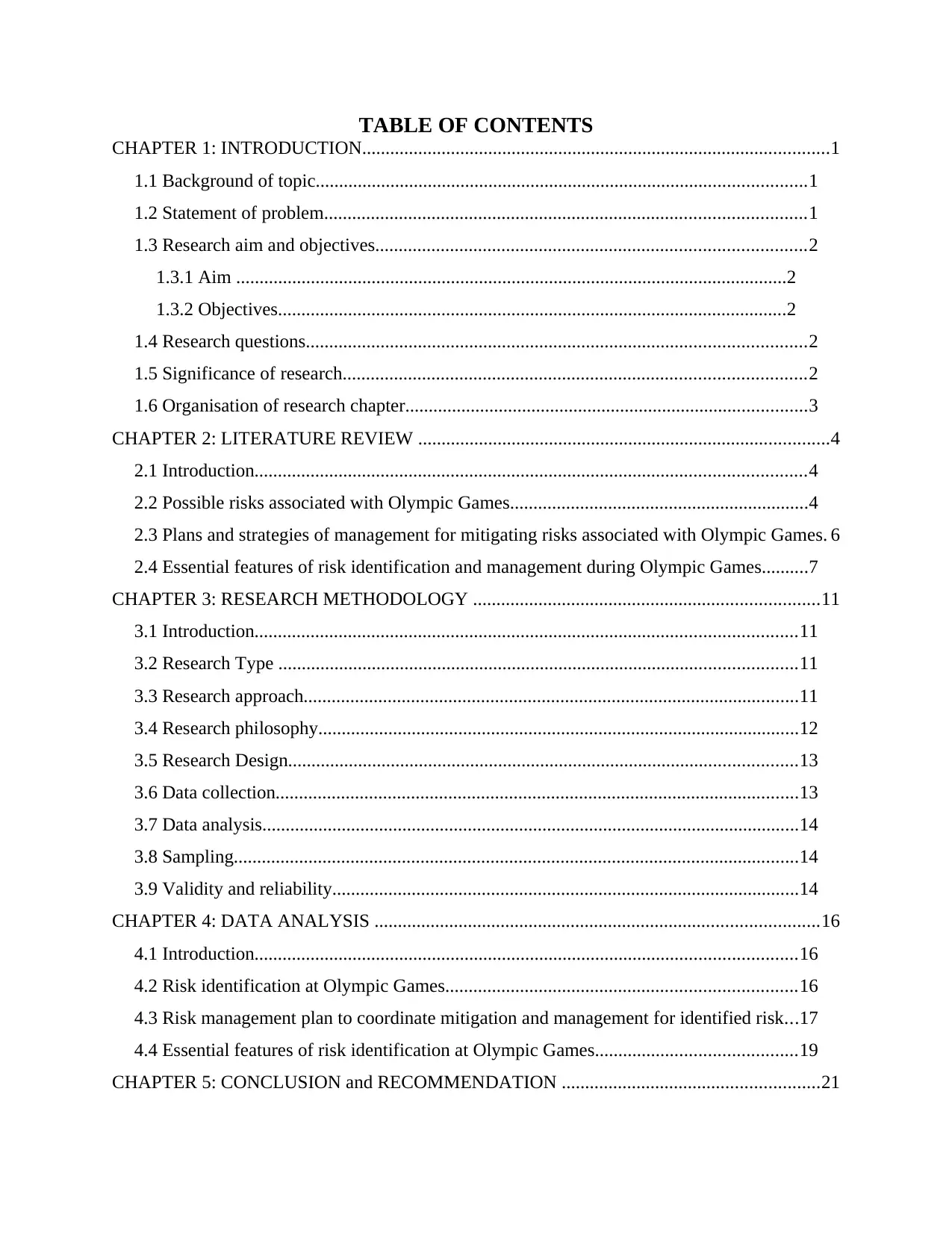
TABLE OF CONTENTS
CHAPTER 1: INTRODUCTION....................................................................................................1
1.1 Background of topic.........................................................................................................1
1.2 Statement of problem.......................................................................................................1
1.3 Research aim and objectives............................................................................................2
1.3.1 Aim ......................................................................................................................2
1.3.2 Objectives.............................................................................................................2
1.4 Research questions...........................................................................................................2
1.5 Significance of research...................................................................................................2
1.6 Organisation of research chapter......................................................................................3
CHAPTER 2: LITERATURE REVIEW ........................................................................................4
2.1 Introduction......................................................................................................................4
2.2 Possible risks associated with Olympic Games................................................................4
2.3 Plans and strategies of management for mitigating risks associated with Olympic Games. 6
2.4 Essential features of risk identification and management during Olympic Games..........7
CHAPTER 3: RESEARCH METHODOLOGY ..........................................................................11
3.1 Introduction....................................................................................................................11
3.2 Research Type ...............................................................................................................11
3.3 Research approach..........................................................................................................11
3.4 Research philosophy.......................................................................................................12
3.5 Research Design.............................................................................................................13
3.6 Data collection................................................................................................................13
3.7 Data analysis...................................................................................................................14
3.8 Sampling.........................................................................................................................14
3.9 Validity and reliability....................................................................................................14
CHAPTER 4: DATA ANALYSIS ...............................................................................................16
4.1 Introduction....................................................................................................................16
4.2 Risk identification at Olympic Games...........................................................................16
4.3 Risk management plan to coordinate mitigation and management for identified risk...17
4.4 Essential features of risk identification at Olympic Games...........................................19
CHAPTER 5: CONCLUSION and RECOMMENDATION .......................................................21
CHAPTER 1: INTRODUCTION....................................................................................................1
1.1 Background of topic.........................................................................................................1
1.2 Statement of problem.......................................................................................................1
1.3 Research aim and objectives............................................................................................2
1.3.1 Aim ......................................................................................................................2
1.3.2 Objectives.............................................................................................................2
1.4 Research questions...........................................................................................................2
1.5 Significance of research...................................................................................................2
1.6 Organisation of research chapter......................................................................................3
CHAPTER 2: LITERATURE REVIEW ........................................................................................4
2.1 Introduction......................................................................................................................4
2.2 Possible risks associated with Olympic Games................................................................4
2.3 Plans and strategies of management for mitigating risks associated with Olympic Games. 6
2.4 Essential features of risk identification and management during Olympic Games..........7
CHAPTER 3: RESEARCH METHODOLOGY ..........................................................................11
3.1 Introduction....................................................................................................................11
3.2 Research Type ...............................................................................................................11
3.3 Research approach..........................................................................................................11
3.4 Research philosophy.......................................................................................................12
3.5 Research Design.............................................................................................................13
3.6 Data collection................................................................................................................13
3.7 Data analysis...................................................................................................................14
3.8 Sampling.........................................................................................................................14
3.9 Validity and reliability....................................................................................................14
CHAPTER 4: DATA ANALYSIS ...............................................................................................16
4.1 Introduction....................................................................................................................16
4.2 Risk identification at Olympic Games...........................................................................16
4.3 Risk management plan to coordinate mitigation and management for identified risk...17
4.4 Essential features of risk identification at Olympic Games...........................................19
CHAPTER 5: CONCLUSION and RECOMMENDATION .......................................................21

Recommendations................................................................................................................21
REFERENCES..............................................................................................................................23
REFERENCES..............................................................................................................................23
⊘ This is a preview!⊘
Do you want full access?
Subscribe today to unlock all pages.

Trusted by 1+ million students worldwide
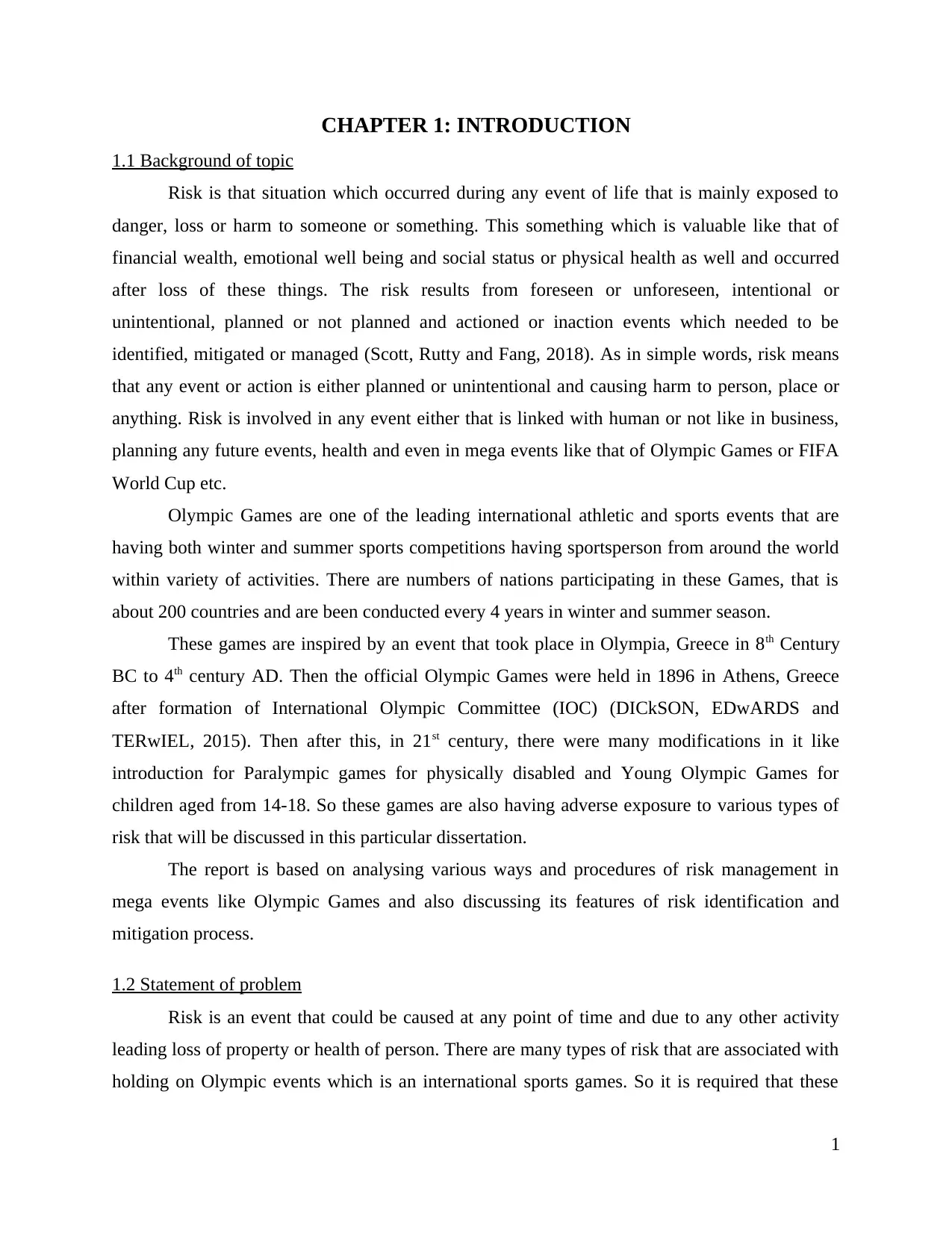
CHAPTER 1: INTRODUCTION
1.1 Background of topic
Risk is that situation which occurred during any event of life that is mainly exposed to
danger, loss or harm to someone or something. This something which is valuable like that of
financial wealth, emotional well being and social status or physical health as well and occurred
after loss of these things. The risk results from foreseen or unforeseen, intentional or
unintentional, planned or not planned and actioned or inaction events which needed to be
identified, mitigated or managed (Scott, Rutty and Fang, 2018). As in simple words, risk means
that any event or action is either planned or unintentional and causing harm to person, place or
anything. Risk is involved in any event either that is linked with human or not like in business,
planning any future events, health and even in mega events like that of Olympic Games or FIFA
World Cup etc.
Olympic Games are one of the leading international athletic and sports events that are
having both winter and summer sports competitions having sportsperson from around the world
within variety of activities. There are numbers of nations participating in these Games, that is
about 200 countries and are been conducted every 4 years in winter and summer season.
These games are inspired by an event that took place in Olympia, Greece in 8th Century
BC to 4th century AD. Then the official Olympic Games were held in 1896 in Athens, Greece
after formation of International Olympic Committee (IOC) (DICkSON, EDwARDS and
TERwIEL, 2015). Then after this, in 21st century, there were many modifications in it like
introduction for Paralympic games for physically disabled and Young Olympic Games for
children aged from 14-18. So these games are also having adverse exposure to various types of
risk that will be discussed in this particular dissertation.
The report is based on analysing various ways and procedures of risk management in
mega events like Olympic Games and also discussing its features of risk identification and
mitigation process.
1.2 Statement of problem
Risk is an event that could be caused at any point of time and due to any other activity
leading loss of property or health of person. There are many types of risk that are associated with
holding on Olympic events which is an international sports games. So it is required that these
1
1.1 Background of topic
Risk is that situation which occurred during any event of life that is mainly exposed to
danger, loss or harm to someone or something. This something which is valuable like that of
financial wealth, emotional well being and social status or physical health as well and occurred
after loss of these things. The risk results from foreseen or unforeseen, intentional or
unintentional, planned or not planned and actioned or inaction events which needed to be
identified, mitigated or managed (Scott, Rutty and Fang, 2018). As in simple words, risk means
that any event or action is either planned or unintentional and causing harm to person, place or
anything. Risk is involved in any event either that is linked with human or not like in business,
planning any future events, health and even in mega events like that of Olympic Games or FIFA
World Cup etc.
Olympic Games are one of the leading international athletic and sports events that are
having both winter and summer sports competitions having sportsperson from around the world
within variety of activities. There are numbers of nations participating in these Games, that is
about 200 countries and are been conducted every 4 years in winter and summer season.
These games are inspired by an event that took place in Olympia, Greece in 8th Century
BC to 4th century AD. Then the official Olympic Games were held in 1896 in Athens, Greece
after formation of International Olympic Committee (IOC) (DICkSON, EDwARDS and
TERwIEL, 2015). Then after this, in 21st century, there were many modifications in it like
introduction for Paralympic games for physically disabled and Young Olympic Games for
children aged from 14-18. So these games are also having adverse exposure to various types of
risk that will be discussed in this particular dissertation.
The report is based on analysing various ways and procedures of risk management in
mega events like Olympic Games and also discussing its features of risk identification and
mitigation process.
1.2 Statement of problem
Risk is an event that could be caused at any point of time and due to any other activity
leading loss of property or health of person. There are many types of risk that are associated with
holding on Olympic events which is an international sports games. So it is required that these
1
Paraphrase This Document
Need a fresh take? Get an instant paraphrase of this document with our AI Paraphraser
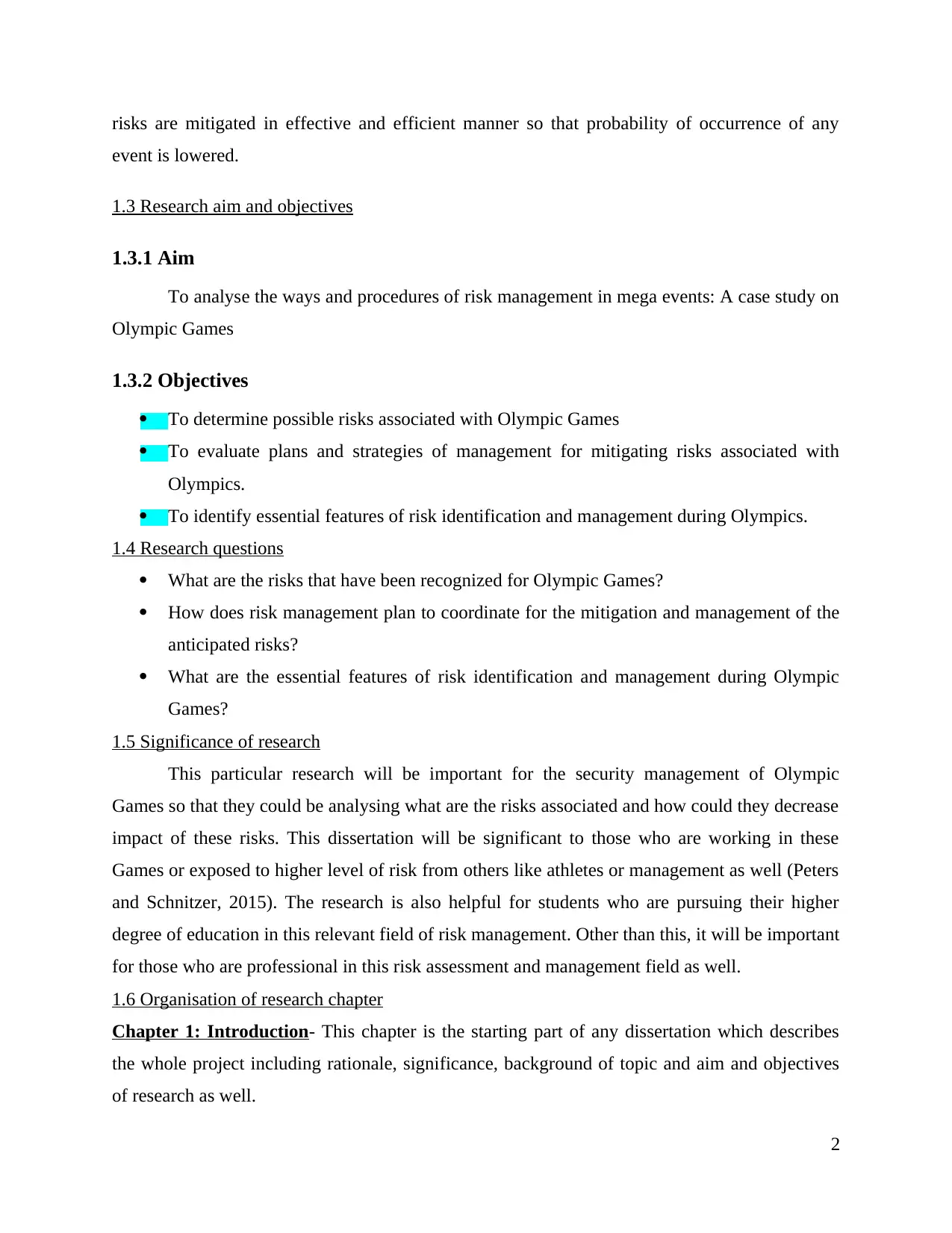
risks are mitigated in effective and efficient manner so that probability of occurrence of any
event is lowered.
1.3 Research aim and objectives
1.3.1 Aim
To analyse the ways and procedures of risk management in mega events: A case study on
Olympic Games
1.3.2 Objectives
To determine possible risks associated with Olympic Games
To evaluate plans and strategies of management for mitigating risks associated with
Olympics.
To identify essential features of risk identification and management during Olympics.
1.4 Research questions
What are the risks that have been recognized for Olympic Games?
How does risk management plan to coordinate for the mitigation and management of the
anticipated risks?
What are the essential features of risk identification and management during Olympic
Games?
1.5 Significance of research
This particular research will be important for the security management of Olympic
Games so that they could be analysing what are the risks associated and how could they decrease
impact of these risks. This dissertation will be significant to those who are working in these
Games or exposed to higher level of risk from others like athletes or management as well (Peters
and Schnitzer, 2015). The research is also helpful for students who are pursuing their higher
degree of education in this relevant field of risk management. Other than this, it will be important
for those who are professional in this risk assessment and management field as well.
1.6 Organisation of research chapter
Chapter 1: Introduction- This chapter is the starting part of any dissertation which describes
the whole project including rationale, significance, background of topic and aim and objectives
of research as well.
2
event is lowered.
1.3 Research aim and objectives
1.3.1 Aim
To analyse the ways and procedures of risk management in mega events: A case study on
Olympic Games
1.3.2 Objectives
To determine possible risks associated with Olympic Games
To evaluate plans and strategies of management for mitigating risks associated with
Olympics.
To identify essential features of risk identification and management during Olympics.
1.4 Research questions
What are the risks that have been recognized for Olympic Games?
How does risk management plan to coordinate for the mitigation and management of the
anticipated risks?
What are the essential features of risk identification and management during Olympic
Games?
1.5 Significance of research
This particular research will be important for the security management of Olympic
Games so that they could be analysing what are the risks associated and how could they decrease
impact of these risks. This dissertation will be significant to those who are working in these
Games or exposed to higher level of risk from others like athletes or management as well (Peters
and Schnitzer, 2015). The research is also helpful for students who are pursuing their higher
degree of education in this relevant field of risk management. Other than this, it will be important
for those who are professional in this risk assessment and management field as well.
1.6 Organisation of research chapter
Chapter 1: Introduction- This chapter is the starting part of any dissertation which describes
the whole project including rationale, significance, background of topic and aim and objectives
of research as well.
2
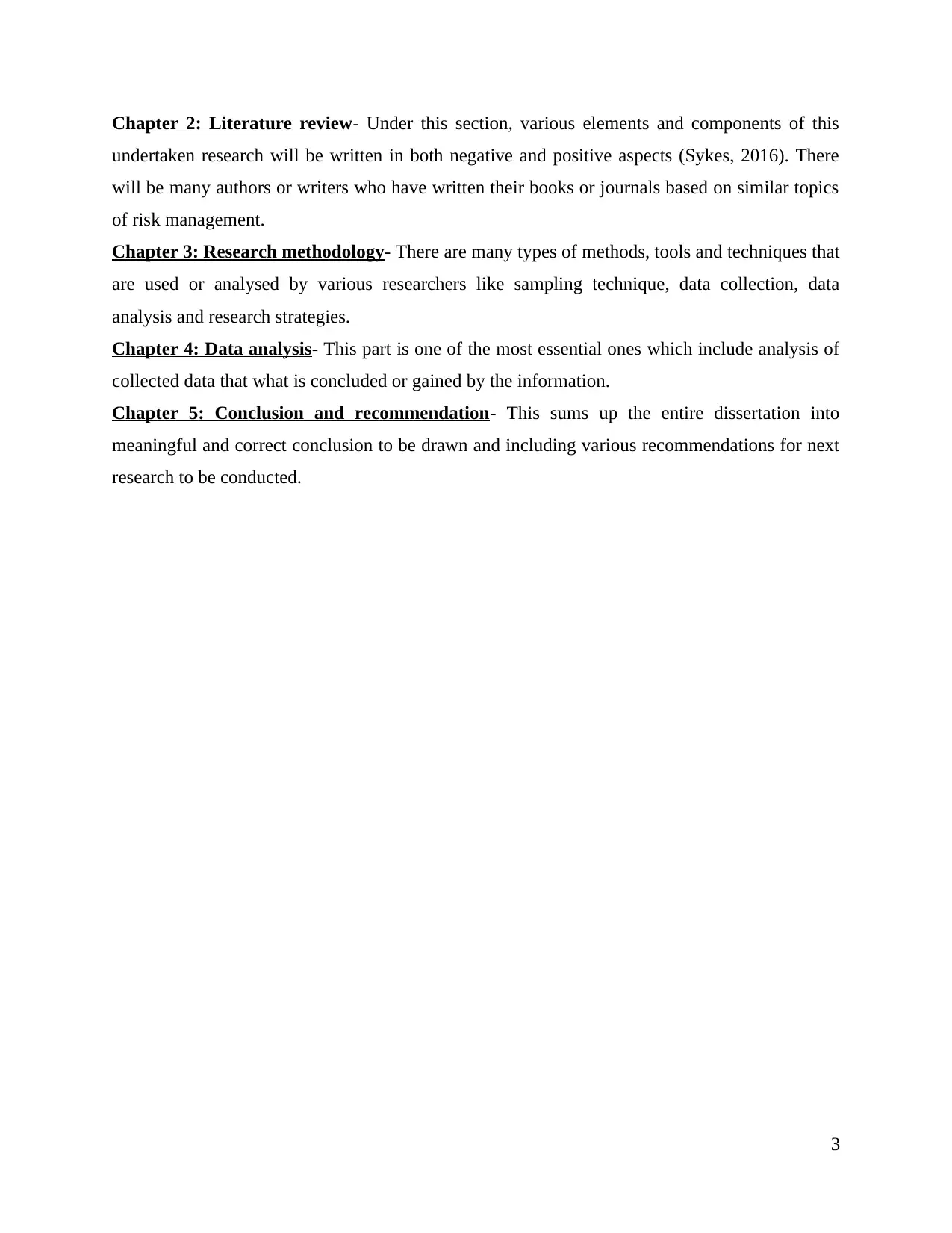
Chapter 2: Literature review- Under this section, various elements and components of this
undertaken research will be written in both negative and positive aspects (Sykes, 2016). There
will be many authors or writers who have written their books or journals based on similar topics
of risk management.
Chapter 3: Research methodology- There are many types of methods, tools and techniques that
are used or analysed by various researchers like sampling technique, data collection, data
analysis and research strategies.
Chapter 4: Data analysis- This part is one of the most essential ones which include analysis of
collected data that what is concluded or gained by the information.
Chapter 5: Conclusion and recommendation- This sums up the entire dissertation into
meaningful and correct conclusion to be drawn and including various recommendations for next
research to be conducted.
3
undertaken research will be written in both negative and positive aspects (Sykes, 2016). There
will be many authors or writers who have written their books or journals based on similar topics
of risk management.
Chapter 3: Research methodology- There are many types of methods, tools and techniques that
are used or analysed by various researchers like sampling technique, data collection, data
analysis and research strategies.
Chapter 4: Data analysis- This part is one of the most essential ones which include analysis of
collected data that what is concluded or gained by the information.
Chapter 5: Conclusion and recommendation- This sums up the entire dissertation into
meaningful and correct conclusion to be drawn and including various recommendations for next
research to be conducted.
3
⊘ This is a preview!⊘
Do you want full access?
Subscribe today to unlock all pages.

Trusted by 1+ million students worldwide
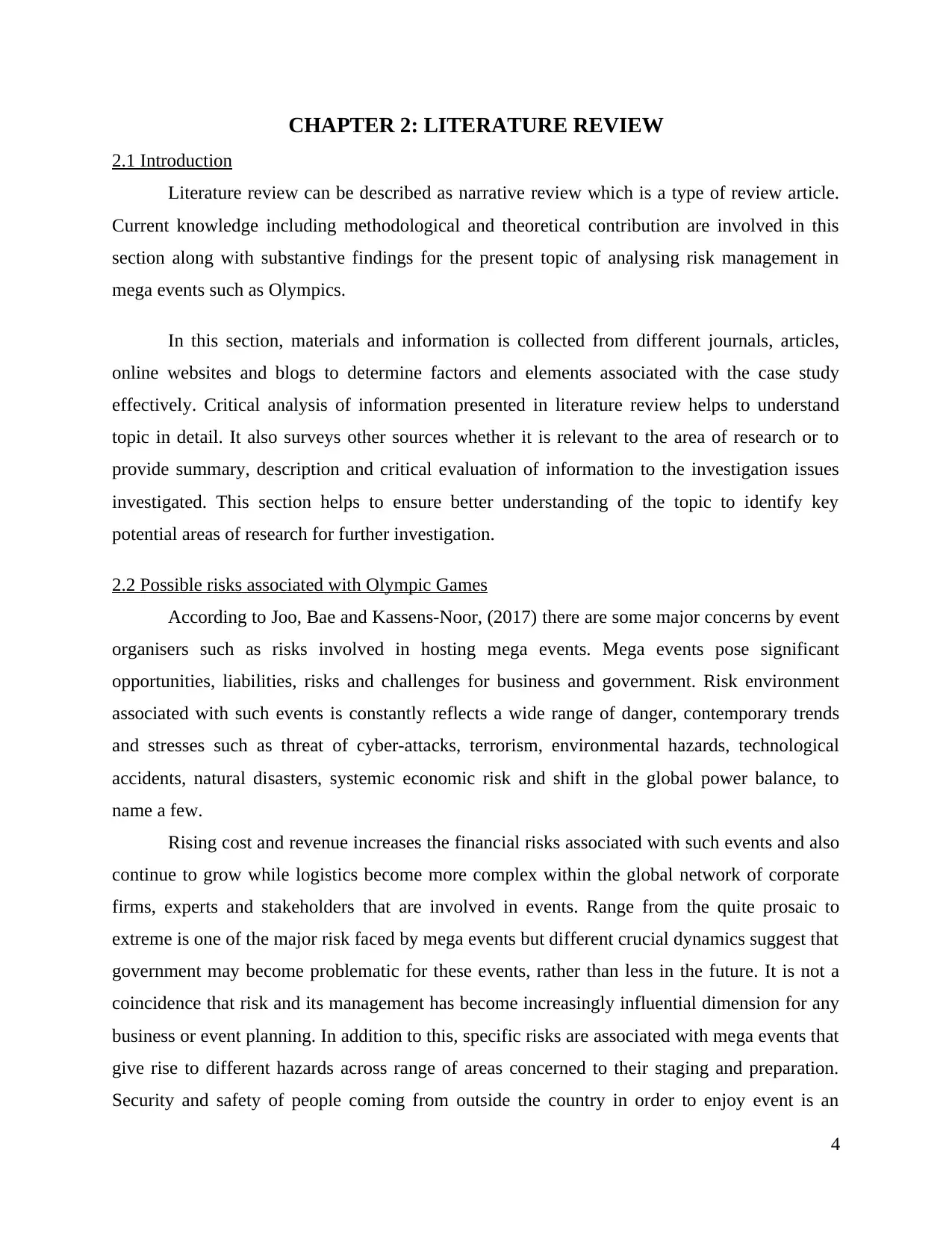
CHAPTER 2: LITERATURE REVIEW
2.1 Introduction
Literature review can be described as narrative review which is a type of review article.
Current knowledge including methodological and theoretical contribution are involved in this
section along with substantive findings for the present topic of analysing risk management in
mega events such as Olympics.
In this section, materials and information is collected from different journals, articles,
online websites and blogs to determine factors and elements associated with the case study
effectively. Critical analysis of information presented in literature review helps to understand
topic in detail. It also surveys other sources whether it is relevant to the area of research or to
provide summary, description and critical evaluation of information to the investigation issues
investigated. This section helps to ensure better understanding of the topic to identify key
potential areas of research for further investigation.
2.2 Possible risks associated with Olympic Games
According to Joo, Bae and Kassens-Noor, (2017) there are some major concerns by event
organisers such as risks involved in hosting mega events. Mega events pose significant
opportunities, liabilities, risks and challenges for business and government. Risk environment
associated with such events is constantly reflects a wide range of danger, contemporary trends
and stresses such as threat of cyber-attacks, terrorism, environmental hazards, technological
accidents, natural disasters, systemic economic risk and shift in the global power balance, to
name a few.
Rising cost and revenue increases the financial risks associated with such events and also
continue to grow while logistics become more complex within the global network of corporate
firms, experts and stakeholders that are involved in events. Range from the quite prosaic to
extreme is one of the major risk faced by mega events but different crucial dynamics suggest that
government may become problematic for these events, rather than less in the future. It is not a
coincidence that risk and its management has become increasingly influential dimension for any
business or event planning. In addition to this, specific risks are associated with mega events that
give rise to different hazards across range of areas concerned to their staging and preparation.
Security and safety of people coming from outside the country in order to enjoy event is an
4
2.1 Introduction
Literature review can be described as narrative review which is a type of review article.
Current knowledge including methodological and theoretical contribution are involved in this
section along with substantive findings for the present topic of analysing risk management in
mega events such as Olympics.
In this section, materials and information is collected from different journals, articles,
online websites and blogs to determine factors and elements associated with the case study
effectively. Critical analysis of information presented in literature review helps to understand
topic in detail. It also surveys other sources whether it is relevant to the area of research or to
provide summary, description and critical evaluation of information to the investigation issues
investigated. This section helps to ensure better understanding of the topic to identify key
potential areas of research for further investigation.
2.2 Possible risks associated with Olympic Games
According to Joo, Bae and Kassens-Noor, (2017) there are some major concerns by event
organisers such as risks involved in hosting mega events. Mega events pose significant
opportunities, liabilities, risks and challenges for business and government. Risk environment
associated with such events is constantly reflects a wide range of danger, contemporary trends
and stresses such as threat of cyber-attacks, terrorism, environmental hazards, technological
accidents, natural disasters, systemic economic risk and shift in the global power balance, to
name a few.
Rising cost and revenue increases the financial risks associated with such events and also
continue to grow while logistics become more complex within the global network of corporate
firms, experts and stakeholders that are involved in events. Range from the quite prosaic to
extreme is one of the major risk faced by mega events but different crucial dynamics suggest that
government may become problematic for these events, rather than less in the future. It is not a
coincidence that risk and its management has become increasingly influential dimension for any
business or event planning. In addition to this, specific risks are associated with mega events that
give rise to different hazards across range of areas concerned to their staging and preparation.
Security and safety of people coming from outside the country in order to enjoy event is an
4
Paraphrase This Document
Need a fresh take? Get an instant paraphrase of this document with our AI Paraphraser
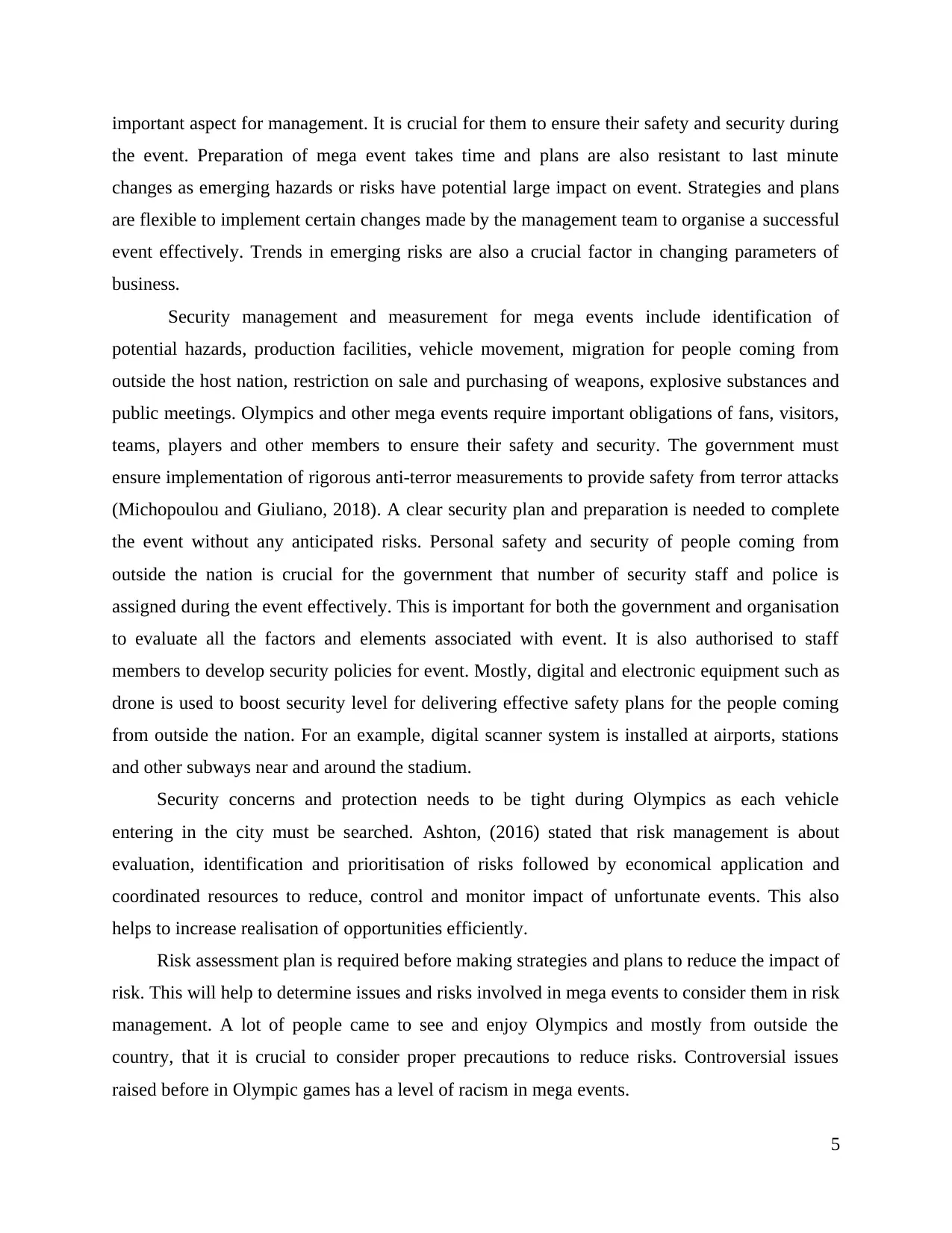
important aspect for management. It is crucial for them to ensure their safety and security during
the event. Preparation of mega event takes time and plans are also resistant to last minute
changes as emerging hazards or risks have potential large impact on event. Strategies and plans
are flexible to implement certain changes made by the management team to organise a successful
event effectively. Trends in emerging risks are also a crucial factor in changing parameters of
business.
Security management and measurement for mega events include identification of
potential hazards, production facilities, vehicle movement, migration for people coming from
outside the host nation, restriction on sale and purchasing of weapons, explosive substances and
public meetings. Olympics and other mega events require important obligations of fans, visitors,
teams, players and other members to ensure their safety and security. The government must
ensure implementation of rigorous anti-terror measurements to provide safety from terror attacks
(Michopoulou and Giuliano, 2018). A clear security plan and preparation is needed to complete
the event without any anticipated risks. Personal safety and security of people coming from
outside the nation is crucial for the government that number of security staff and police is
assigned during the event effectively. This is important for both the government and organisation
to evaluate all the factors and elements associated with event. It is also authorised to staff
members to develop security policies for event. Mostly, digital and electronic equipment such as
drone is used to boost security level for delivering effective safety plans for the people coming
from outside the nation. For an example, digital scanner system is installed at airports, stations
and other subways near and around the stadium.
Security concerns and protection needs to be tight during Olympics as each vehicle
entering in the city must be searched. Ashton, (2016) stated that risk management is about
evaluation, identification and prioritisation of risks followed by economical application and
coordinated resources to reduce, control and monitor impact of unfortunate events. This also
helps to increase realisation of opportunities efficiently.
Risk assessment plan is required before making strategies and plans to reduce the impact of
risk. This will help to determine issues and risks involved in mega events to consider them in risk
management. A lot of people came to see and enjoy Olympics and mostly from outside the
country, that it is crucial to consider proper precautions to reduce risks. Controversial issues
raised before in Olympic games has a level of racism in mega events.
5
the event. Preparation of mega event takes time and plans are also resistant to last minute
changes as emerging hazards or risks have potential large impact on event. Strategies and plans
are flexible to implement certain changes made by the management team to organise a successful
event effectively. Trends in emerging risks are also a crucial factor in changing parameters of
business.
Security management and measurement for mega events include identification of
potential hazards, production facilities, vehicle movement, migration for people coming from
outside the host nation, restriction on sale and purchasing of weapons, explosive substances and
public meetings. Olympics and other mega events require important obligations of fans, visitors,
teams, players and other members to ensure their safety and security. The government must
ensure implementation of rigorous anti-terror measurements to provide safety from terror attacks
(Michopoulou and Giuliano, 2018). A clear security plan and preparation is needed to complete
the event without any anticipated risks. Personal safety and security of people coming from
outside the nation is crucial for the government that number of security staff and police is
assigned during the event effectively. This is important for both the government and organisation
to evaluate all the factors and elements associated with event. It is also authorised to staff
members to develop security policies for event. Mostly, digital and electronic equipment such as
drone is used to boost security level for delivering effective safety plans for the people coming
from outside the nation. For an example, digital scanner system is installed at airports, stations
and other subways near and around the stadium.
Security concerns and protection needs to be tight during Olympics as each vehicle
entering in the city must be searched. Ashton, (2016) stated that risk management is about
evaluation, identification and prioritisation of risks followed by economical application and
coordinated resources to reduce, control and monitor impact of unfortunate events. This also
helps to increase realisation of opportunities efficiently.
Risk assessment plan is required before making strategies and plans to reduce the impact of
risk. This will help to determine issues and risks involved in mega events to consider them in risk
management. A lot of people came to see and enjoy Olympics and mostly from outside the
country, that it is crucial to consider proper precautions to reduce risks. Controversial issues
raised before in Olympic games has a level of racism in mega events.
5
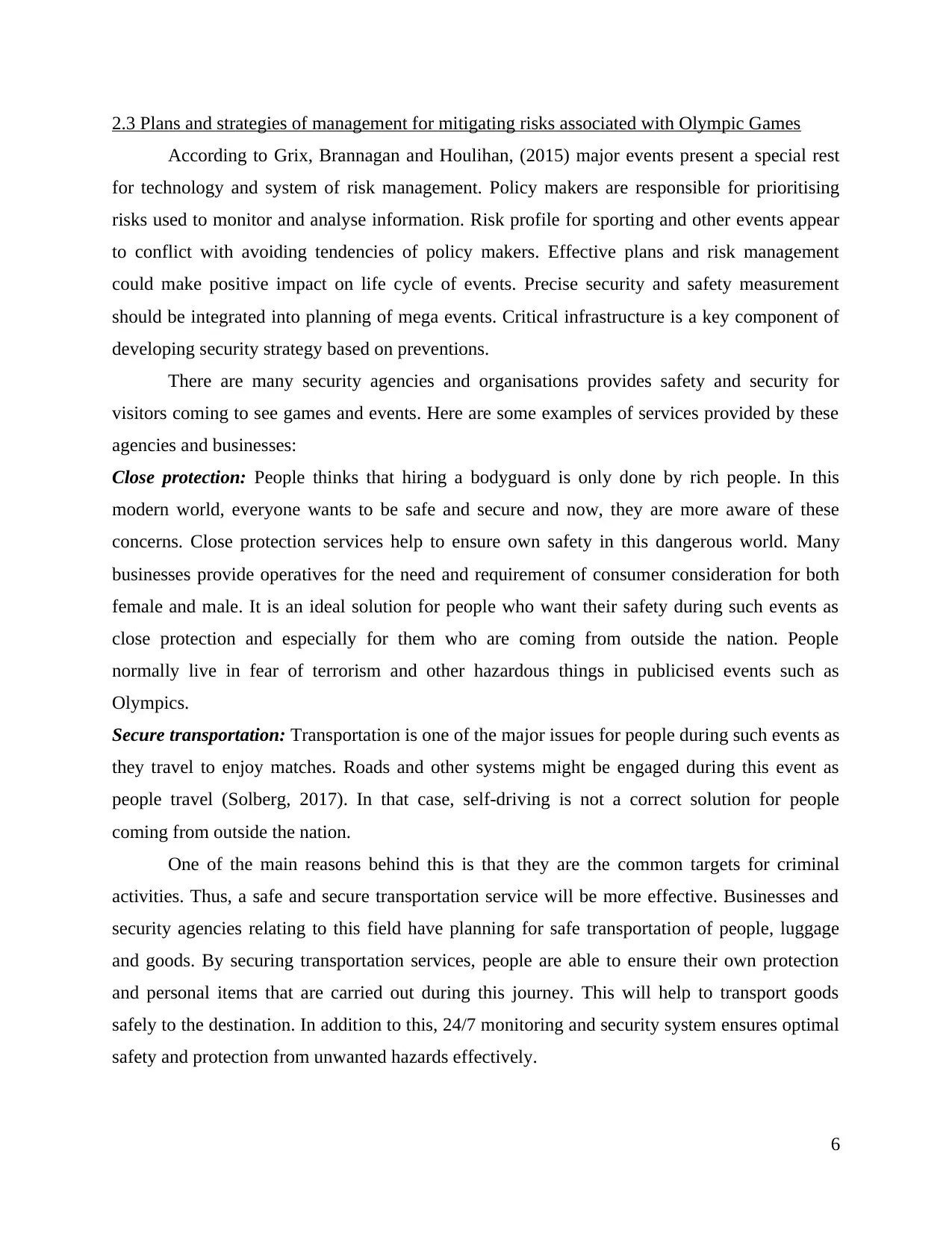
2.3 Plans and strategies of management for mitigating risks associated with Olympic Games
According to Grix, Brannagan and Houlihan, (2015) major events present a special rest
for technology and system of risk management. Policy makers are responsible for prioritising
risks used to monitor and analyse information. Risk profile for sporting and other events appear
to conflict with avoiding tendencies of policy makers. Effective plans and risk management
could make positive impact on life cycle of events. Precise security and safety measurement
should be integrated into planning of mega events. Critical infrastructure is a key component of
developing security strategy based on preventions.
There are many security agencies and organisations provides safety and security for
visitors coming to see games and events. Here are some examples of services provided by these
agencies and businesses:
Close protection: People thinks that hiring a bodyguard is only done by rich people. In this
modern world, everyone wants to be safe and secure and now, they are more aware of these
concerns. Close protection services help to ensure own safety in this dangerous world. Many
businesses provide operatives for the need and requirement of consumer consideration for both
female and male. It is an ideal solution for people who want their safety during such events as
close protection and especially for them who are coming from outside the nation. People
normally live in fear of terrorism and other hazardous things in publicised events such as
Olympics.
Secure transportation: Transportation is one of the major issues for people during such events as
they travel to enjoy matches. Roads and other systems might be engaged during this event as
people travel (Solberg, 2017). In that case, self-driving is not a correct solution for people
coming from outside the nation.
One of the main reasons behind this is that they are the common targets for criminal
activities. Thus, a safe and secure transportation service will be more effective. Businesses and
security agencies relating to this field have planning for safe transportation of people, luggage
and goods. By securing transportation services, people are able to ensure their own protection
and personal items that are carried out during this journey. This will help to transport goods
safely to the destination. In addition to this, 24/7 monitoring and security system ensures optimal
safety and protection from unwanted hazards effectively.
6
According to Grix, Brannagan and Houlihan, (2015) major events present a special rest
for technology and system of risk management. Policy makers are responsible for prioritising
risks used to monitor and analyse information. Risk profile for sporting and other events appear
to conflict with avoiding tendencies of policy makers. Effective plans and risk management
could make positive impact on life cycle of events. Precise security and safety measurement
should be integrated into planning of mega events. Critical infrastructure is a key component of
developing security strategy based on preventions.
There are many security agencies and organisations provides safety and security for
visitors coming to see games and events. Here are some examples of services provided by these
agencies and businesses:
Close protection: People thinks that hiring a bodyguard is only done by rich people. In this
modern world, everyone wants to be safe and secure and now, they are more aware of these
concerns. Close protection services help to ensure own safety in this dangerous world. Many
businesses provide operatives for the need and requirement of consumer consideration for both
female and male. It is an ideal solution for people who want their safety during such events as
close protection and especially for them who are coming from outside the nation. People
normally live in fear of terrorism and other hazardous things in publicised events such as
Olympics.
Secure transportation: Transportation is one of the major issues for people during such events as
they travel to enjoy matches. Roads and other systems might be engaged during this event as
people travel (Solberg, 2017). In that case, self-driving is not a correct solution for people
coming from outside the nation.
One of the main reasons behind this is that they are the common targets for criminal
activities. Thus, a safe and secure transportation service will be more effective. Businesses and
security agencies relating to this field have planning for safe transportation of people, luggage
and goods. By securing transportation services, people are able to ensure their own protection
and personal items that are carried out during this journey. This will help to transport goods
safely to the destination. In addition to this, 24/7 monitoring and security system ensures optimal
safety and protection from unwanted hazards effectively.
6
⊘ This is a preview!⊘
Do you want full access?
Subscribe today to unlock all pages.

Trusted by 1+ million students worldwide
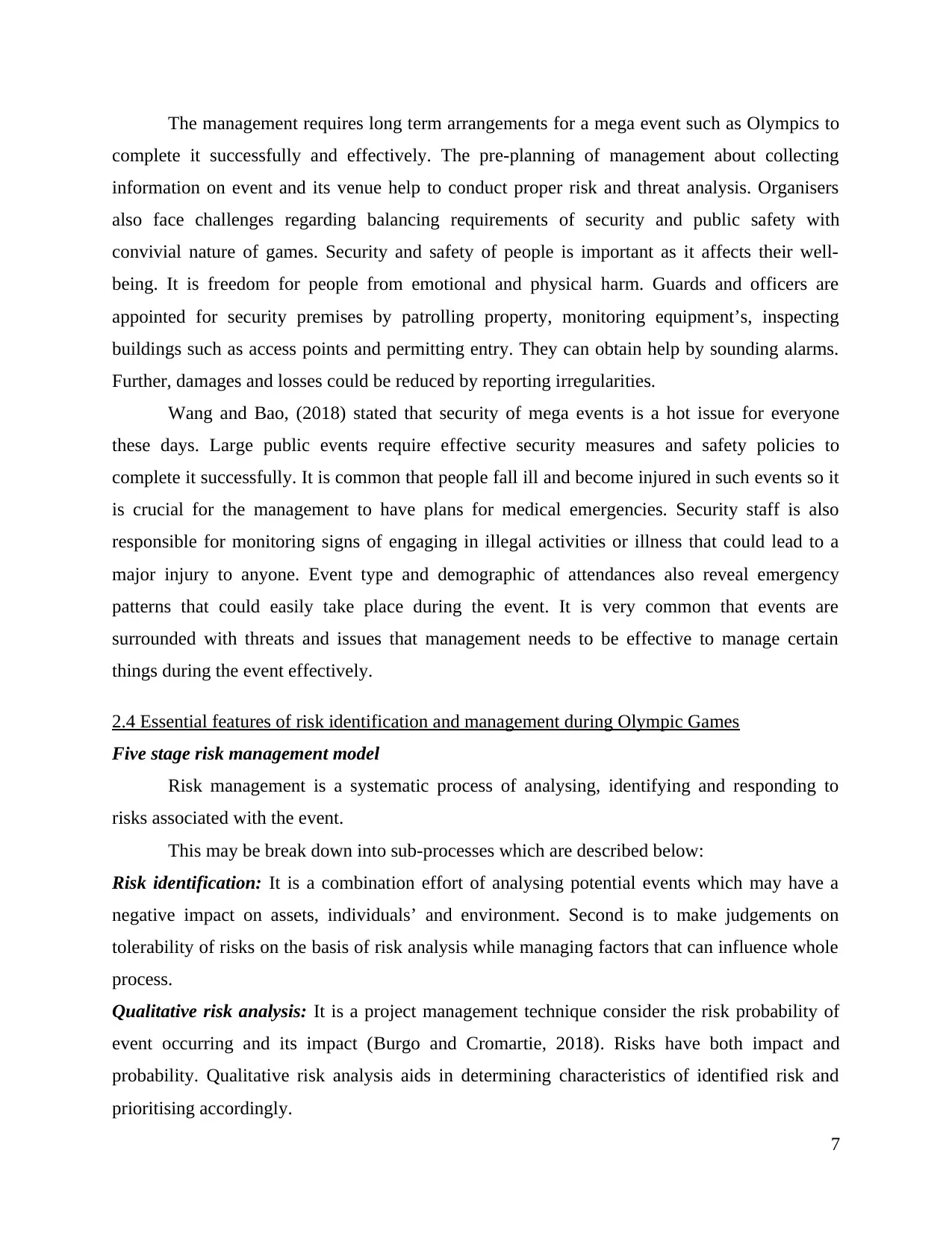
The management requires long term arrangements for a mega event such as Olympics to
complete it successfully and effectively. The pre-planning of management about collecting
information on event and its venue help to conduct proper risk and threat analysis. Organisers
also face challenges regarding balancing requirements of security and public safety with
convivial nature of games. Security and safety of people is important as it affects their well-
being. It is freedom for people from emotional and physical harm. Guards and officers are
appointed for security premises by patrolling property, monitoring equipment’s, inspecting
buildings such as access points and permitting entry. They can obtain help by sounding alarms.
Further, damages and losses could be reduced by reporting irregularities.
Wang and Bao, (2018) stated that security of mega events is a hot issue for everyone
these days. Large public events require effective security measures and safety policies to
complete it successfully. It is common that people fall ill and become injured in such events so it
is crucial for the management to have plans for medical emergencies. Security staff is also
responsible for monitoring signs of engaging in illegal activities or illness that could lead to a
major injury to anyone. Event type and demographic of attendances also reveal emergency
patterns that could easily take place during the event. It is very common that events are
surrounded with threats and issues that management needs to be effective to manage certain
things during the event effectively.
2.4 Essential features of risk identification and management during Olympic Games
Five stage risk management model
Risk management is a systematic process of analysing, identifying and responding to
risks associated with the event.
This may be break down into sub-processes which are described below:
Risk identification: It is a combination effort of analysing potential events which may have a
negative impact on assets, individuals’ and environment. Second is to make judgements on
tolerability of risks on the basis of risk analysis while managing factors that can influence whole
process.
Qualitative risk analysis: It is a project management technique consider the risk probability of
event occurring and its impact (Burgo and Cromartie, 2018). Risks have both impact and
probability. Qualitative risk analysis aids in determining characteristics of identified risk and
prioritising accordingly.
7
complete it successfully and effectively. The pre-planning of management about collecting
information on event and its venue help to conduct proper risk and threat analysis. Organisers
also face challenges regarding balancing requirements of security and public safety with
convivial nature of games. Security and safety of people is important as it affects their well-
being. It is freedom for people from emotional and physical harm. Guards and officers are
appointed for security premises by patrolling property, monitoring equipment’s, inspecting
buildings such as access points and permitting entry. They can obtain help by sounding alarms.
Further, damages and losses could be reduced by reporting irregularities.
Wang and Bao, (2018) stated that security of mega events is a hot issue for everyone
these days. Large public events require effective security measures and safety policies to
complete it successfully. It is common that people fall ill and become injured in such events so it
is crucial for the management to have plans for medical emergencies. Security staff is also
responsible for monitoring signs of engaging in illegal activities or illness that could lead to a
major injury to anyone. Event type and demographic of attendances also reveal emergency
patterns that could easily take place during the event. It is very common that events are
surrounded with threats and issues that management needs to be effective to manage certain
things during the event effectively.
2.4 Essential features of risk identification and management during Olympic Games
Five stage risk management model
Risk management is a systematic process of analysing, identifying and responding to
risks associated with the event.
This may be break down into sub-processes which are described below:
Risk identification: It is a combination effort of analysing potential events which may have a
negative impact on assets, individuals’ and environment. Second is to make judgements on
tolerability of risks on the basis of risk analysis while managing factors that can influence whole
process.
Qualitative risk analysis: It is a project management technique consider the risk probability of
event occurring and its impact (Burgo and Cromartie, 2018). Risks have both impact and
probability. Qualitative risk analysis aids in determining characteristics of identified risk and
prioritising accordingly.
7
Paraphrase This Document
Need a fresh take? Get an instant paraphrase of this document with our AI Paraphraser
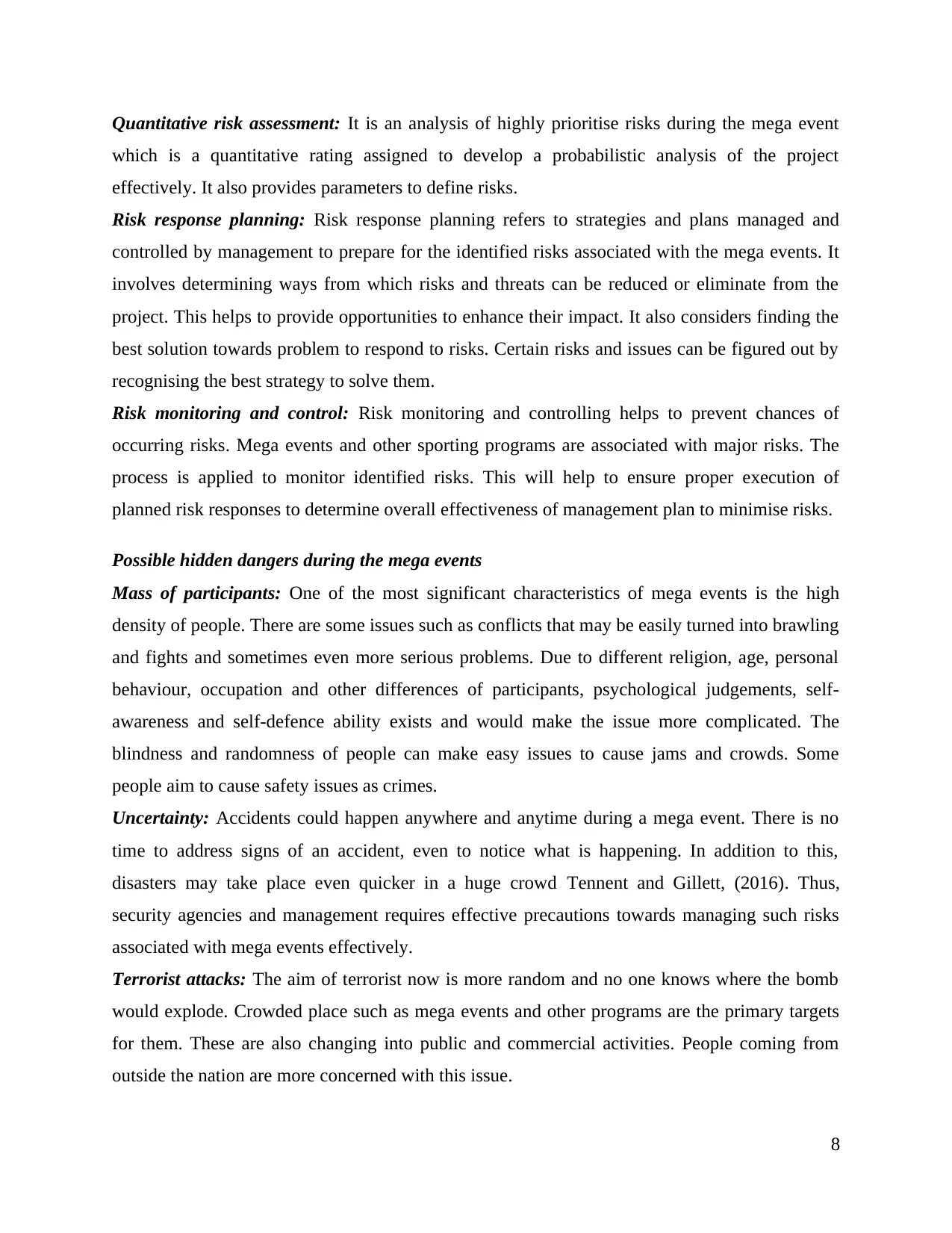
Quantitative risk assessment: It is an analysis of highly prioritise risks during the mega event
which is a quantitative rating assigned to develop a probabilistic analysis of the project
effectively. It also provides parameters to define risks.
Risk response planning: Risk response planning refers to strategies and plans managed and
controlled by management to prepare for the identified risks associated with the mega events. It
involves determining ways from which risks and threats can be reduced or eliminate from the
project. This helps to provide opportunities to enhance their impact. It also considers finding the
best solution towards problem to respond to risks. Certain risks and issues can be figured out by
recognising the best strategy to solve them.
Risk monitoring and control: Risk monitoring and controlling helps to prevent chances of
occurring risks. Mega events and other sporting programs are associated with major risks. The
process is applied to monitor identified risks. This will help to ensure proper execution of
planned risk responses to determine overall effectiveness of management plan to minimise risks.
Possible hidden dangers during the mega events
Mass of participants: One of the most significant characteristics of mega events is the high
density of people. There are some issues such as conflicts that may be easily turned into brawling
and fights and sometimes even more serious problems. Due to different religion, age, personal
behaviour, occupation and other differences of participants, psychological judgements, self-
awareness and self-defence ability exists and would make the issue more complicated. The
blindness and randomness of people can make easy issues to cause jams and crowds. Some
people aim to cause safety issues as crimes.
Uncertainty: Accidents could happen anywhere and anytime during a mega event. There is no
time to address signs of an accident, even to notice what is happening. In addition to this,
disasters may take place even quicker in a huge crowd Tennent and Gillett, (2016). Thus,
security agencies and management requires effective precautions towards managing such risks
associated with mega events effectively.
Terrorist attacks: The aim of terrorist now is more random and no one knows where the bomb
would explode. Crowded place such as mega events and other programs are the primary targets
for them. These are also changing into public and commercial activities. People coming from
outside the nation are more concerned with this issue.
8
which is a quantitative rating assigned to develop a probabilistic analysis of the project
effectively. It also provides parameters to define risks.
Risk response planning: Risk response planning refers to strategies and plans managed and
controlled by management to prepare for the identified risks associated with the mega events. It
involves determining ways from which risks and threats can be reduced or eliminate from the
project. This helps to provide opportunities to enhance their impact. It also considers finding the
best solution towards problem to respond to risks. Certain risks and issues can be figured out by
recognising the best strategy to solve them.
Risk monitoring and control: Risk monitoring and controlling helps to prevent chances of
occurring risks. Mega events and other sporting programs are associated with major risks. The
process is applied to monitor identified risks. This will help to ensure proper execution of
planned risk responses to determine overall effectiveness of management plan to minimise risks.
Possible hidden dangers during the mega events
Mass of participants: One of the most significant characteristics of mega events is the high
density of people. There are some issues such as conflicts that may be easily turned into brawling
and fights and sometimes even more serious problems. Due to different religion, age, personal
behaviour, occupation and other differences of participants, psychological judgements, self-
awareness and self-defence ability exists and would make the issue more complicated. The
blindness and randomness of people can make easy issues to cause jams and crowds. Some
people aim to cause safety issues as crimes.
Uncertainty: Accidents could happen anywhere and anytime during a mega event. There is no
time to address signs of an accident, even to notice what is happening. In addition to this,
disasters may take place even quicker in a huge crowd Tennent and Gillett, (2016). Thus,
security agencies and management requires effective precautions towards managing such risks
associated with mega events effectively.
Terrorist attacks: The aim of terrorist now is more random and no one knows where the bomb
would explode. Crowded place such as mega events and other programs are the primary targets
for them. These are also changing into public and commercial activities. People coming from
outside the nation are more concerned with this issue.
8
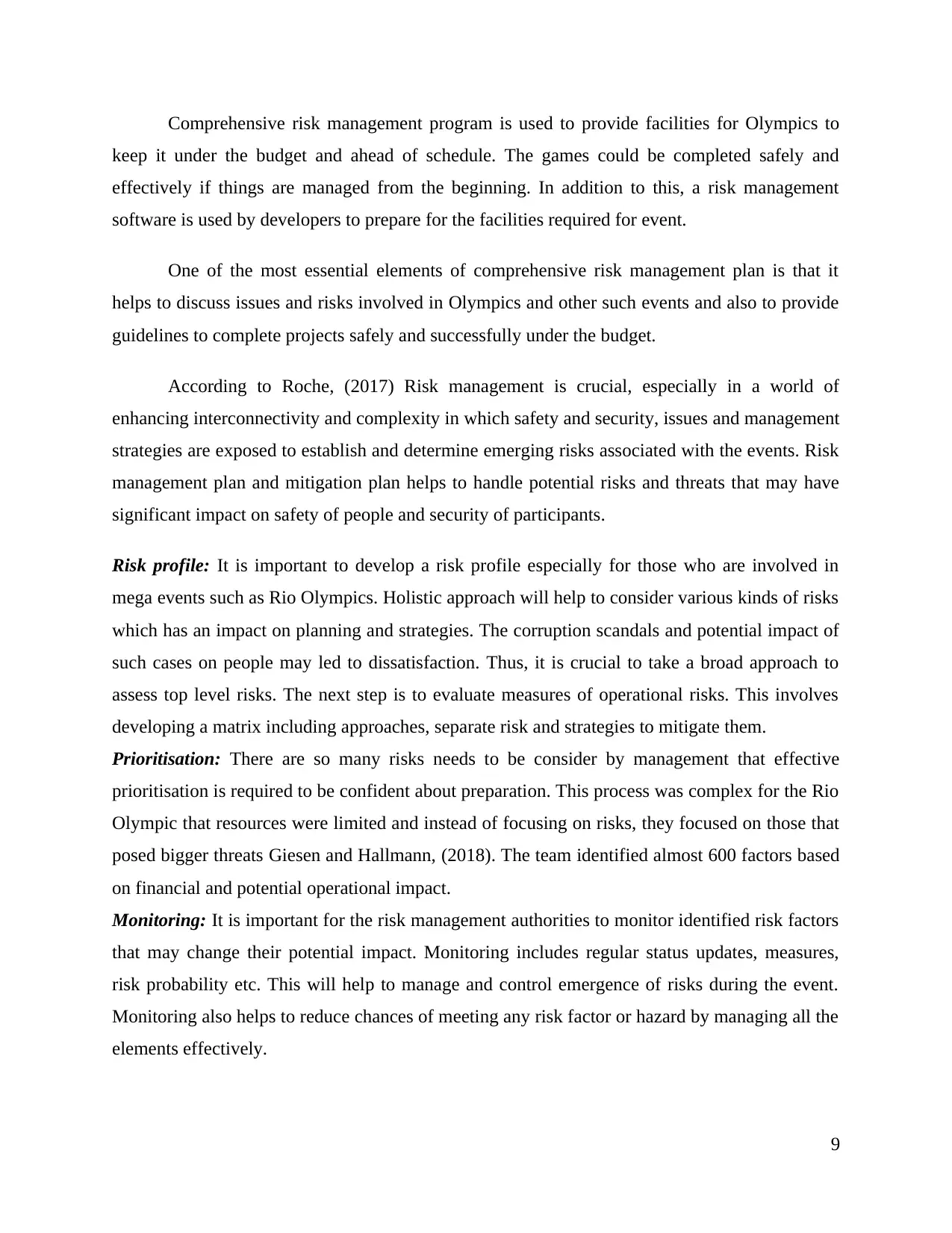
Comprehensive risk management program is used to provide facilities for Olympics to
keep it under the budget and ahead of schedule. The games could be completed safely and
effectively if things are managed from the beginning. In addition to this, a risk management
software is used by developers to prepare for the facilities required for event.
One of the most essential elements of comprehensive risk management plan is that it
helps to discuss issues and risks involved in Olympics and other such events and also to provide
guidelines to complete projects safely and successfully under the budget.
According to Roche, (2017) Risk management is crucial, especially in a world of
enhancing interconnectivity and complexity in which safety and security, issues and management
strategies are exposed to establish and determine emerging risks associated with the events. Risk
management plan and mitigation plan helps to handle potential risks and threats that may have
significant impact on safety of people and security of participants.
Risk profile: It is important to develop a risk profile especially for those who are involved in
mega events such as Rio Olympics. Holistic approach will help to consider various kinds of risks
which has an impact on planning and strategies. The corruption scandals and potential impact of
such cases on people may led to dissatisfaction. Thus, it is crucial to take a broad approach to
assess top level risks. The next step is to evaluate measures of operational risks. This involves
developing a matrix including approaches, separate risk and strategies to mitigate them.
Prioritisation: There are so many risks needs to be consider by management that effective
prioritisation is required to be confident about preparation. This process was complex for the Rio
Olympic that resources were limited and instead of focusing on risks, they focused on those that
posed bigger threats Giesen and Hallmann, (2018). The team identified almost 600 factors based
on financial and potential operational impact.
Monitoring: It is important for the risk management authorities to monitor identified risk factors
that may change their potential impact. Monitoring includes regular status updates, measures,
risk probability etc. This will help to manage and control emergence of risks during the event.
Monitoring also helps to reduce chances of meeting any risk factor or hazard by managing all the
elements effectively.
9
keep it under the budget and ahead of schedule. The games could be completed safely and
effectively if things are managed from the beginning. In addition to this, a risk management
software is used by developers to prepare for the facilities required for event.
One of the most essential elements of comprehensive risk management plan is that it
helps to discuss issues and risks involved in Olympics and other such events and also to provide
guidelines to complete projects safely and successfully under the budget.
According to Roche, (2017) Risk management is crucial, especially in a world of
enhancing interconnectivity and complexity in which safety and security, issues and management
strategies are exposed to establish and determine emerging risks associated with the events. Risk
management plan and mitigation plan helps to handle potential risks and threats that may have
significant impact on safety of people and security of participants.
Risk profile: It is important to develop a risk profile especially for those who are involved in
mega events such as Rio Olympics. Holistic approach will help to consider various kinds of risks
which has an impact on planning and strategies. The corruption scandals and potential impact of
such cases on people may led to dissatisfaction. Thus, it is crucial to take a broad approach to
assess top level risks. The next step is to evaluate measures of operational risks. This involves
developing a matrix including approaches, separate risk and strategies to mitigate them.
Prioritisation: There are so many risks needs to be consider by management that effective
prioritisation is required to be confident about preparation. This process was complex for the Rio
Olympic that resources were limited and instead of focusing on risks, they focused on those that
posed bigger threats Giesen and Hallmann, (2018). The team identified almost 600 factors based
on financial and potential operational impact.
Monitoring: It is important for the risk management authorities to monitor identified risk factors
that may change their potential impact. Monitoring includes regular status updates, measures,
risk probability etc. This will help to manage and control emergence of risks during the event.
Monitoring also helps to reduce chances of meeting any risk factor or hazard by managing all the
elements effectively.
9
⊘ This is a preview!⊘
Do you want full access?
Subscribe today to unlock all pages.

Trusted by 1+ million students worldwide
1 out of 28
Related Documents
Your All-in-One AI-Powered Toolkit for Academic Success.
+13062052269
info@desklib.com
Available 24*7 on WhatsApp / Email
![[object Object]](/_next/static/media/star-bottom.7253800d.svg)
Unlock your academic potential
Copyright © 2020–2025 A2Z Services. All Rights Reserved. Developed and managed by ZUCOL.





